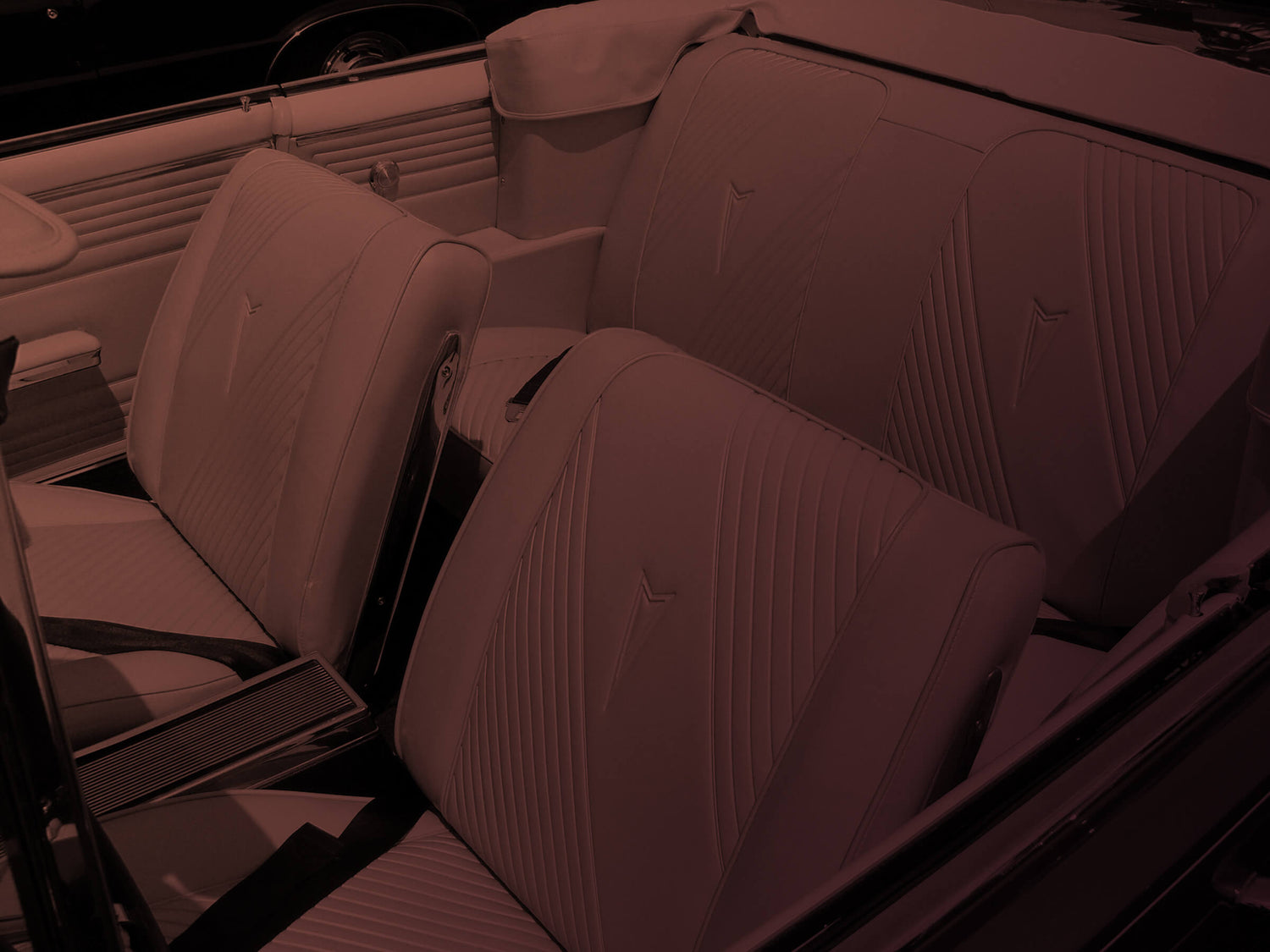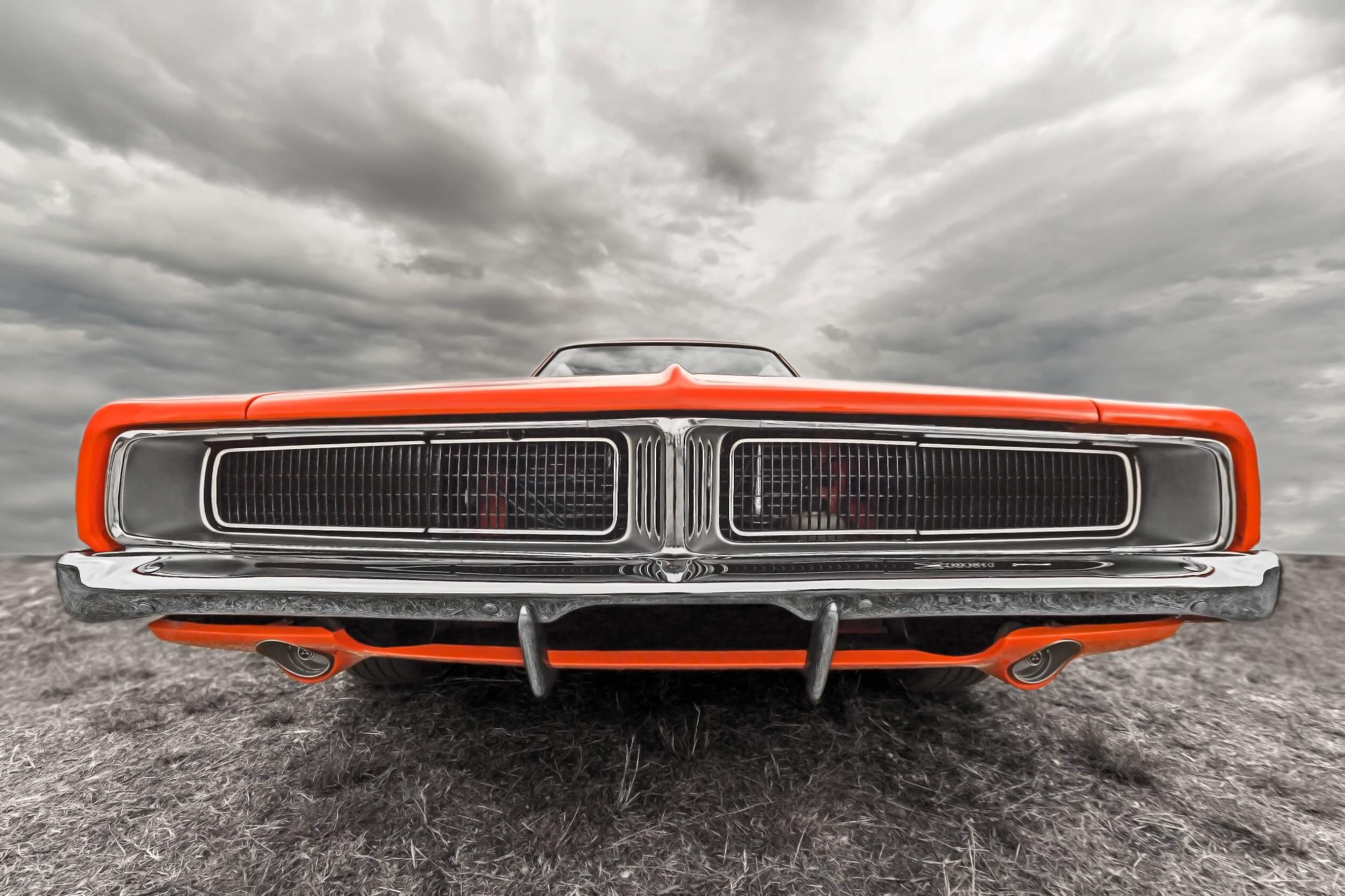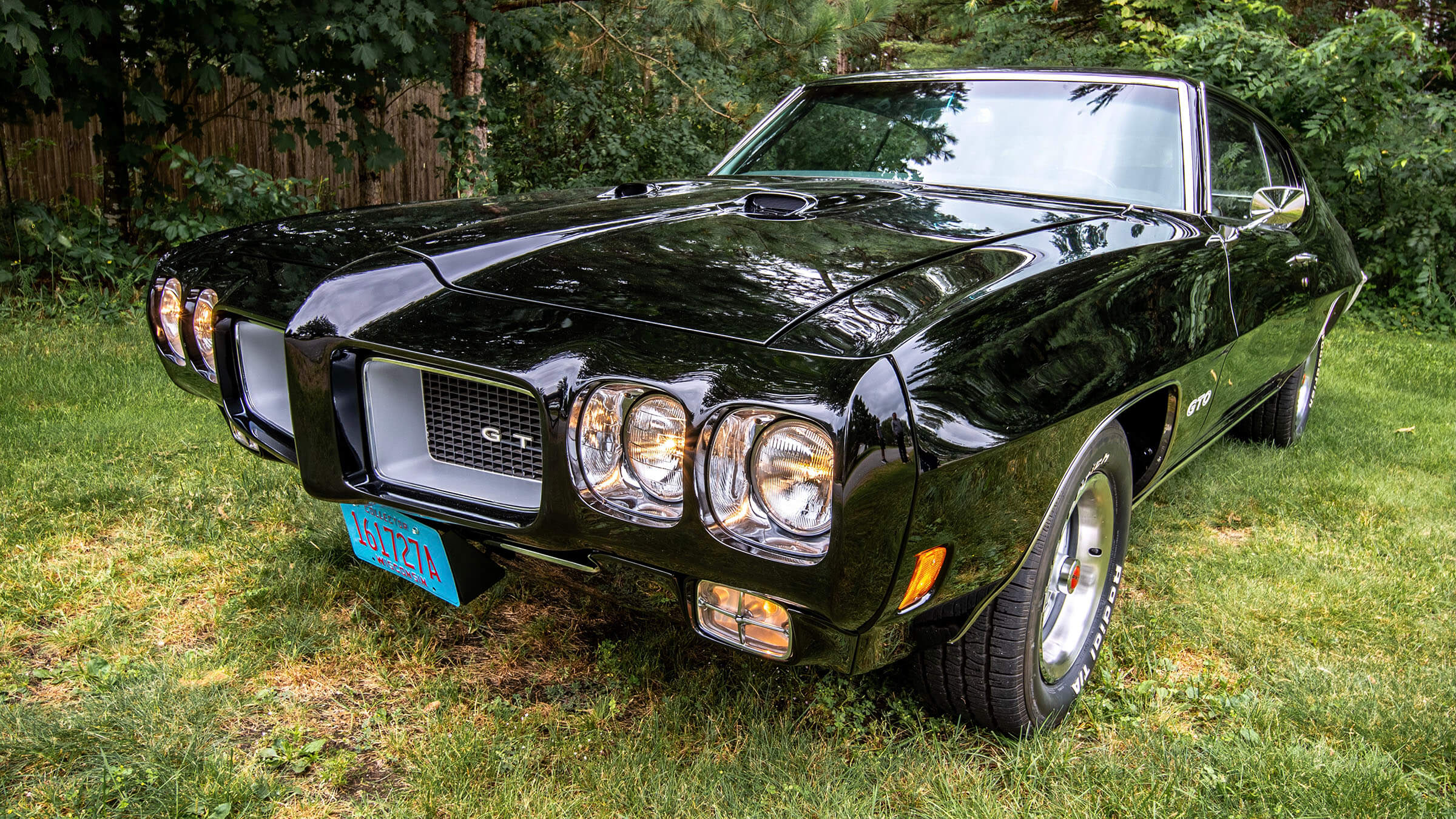Video Transcript
Hi, I’m Ron Halbritter, technical advisor for Legendary Auto Interiors and I’d like to welcome you to Legendary Studios where today we’re going to show you the proper way to install the padding, burlap, and seat upholstery for your 1969 Dodge Charger. We can use this video as a guideline for installing any rear seat from 1966 through 1970 A and B body models.
Now, after a quick teardown of your existing upholstery we’ll show you the necessary steps start to finish to complete the job, and to help us do that is Randy Brown who is our head installer here at Legendary Auto Interiors. Randy is going to show you why Legendary Auto Interiors is the number one choice with restorers, collectors, and enthusiasts worldwide. There really is a difference, so let’s get started.
Our first step will be to put a layer of burlap over the top of our seat springs. We want to anchor all four corners, pulling some tension on it tight. What this will allow it to do is provide some support for your foam so it doesn’t seep down through your seat springs. You want to space your high grains about every five to six inches apart and overlap the front edge and the side edge about two to three inches.
Our first step on our rear seat top will be to measure the distance between the top edge of the seat frame and the distance of the seat springs. We need to make a perfectly straight panel that connects this area. We make this panel out of burlap.
We draw two perfectly straight lines, then we insert a piece of listing wire and fold the burlap edges over and it makes a very straight panel. Now this panel needs to be the correct size—if it’s too wide, the panel will sag and when the cotton wraps over the edge of the seat it will fall down in between the seat springs and the seat frame, and make it too baggy. If it’s too tight, it will affect your seat cover installation. You’ll notice a close-up where the listing wire is placed along the straight line and the burlap is glued over the top of the listing wire onto itself on both sides.
Our first step will be to attach the panel we just finished to the top edge of our seat springs and the rear edge of our seat frame. Space your hog rings out about every five to six inches. Bend the corners over at a sharp 90 degrees and run your hog ring through the burlap around the listing wire and around our seat frame. Repeat the process on the opposite side.
Now that our top panel is attached, we can lay a layer of burlap over the entire face of our rear seat top seat springs. We again want to anchor the corners first pulling some tension on it so it’s tight. Working our way around the entire perimeter, space your hog rings out every five to six inches apart and fold over the corners so they overlap each other.
Repeat the process on the opposite side and move along to the top edge and the corners. We want to fold over the back side of the seat spring and hog ring it to the seat frame.
Starting with the padding on our rear seat bottom, we want to trim our high-density foam about four inches past the outside perimeter edge of our rear seat bottom seat springs. We want to trim off the edges and the corners so it wraps over the top of the seat springs nicely. You’ll notice Randy’s using a foam saw, but you can use a regular razor blade or a good pair of scissors.
After your edges are trimmed, you want to wrap the foam over the edge of the seat springs and hog ring it through the foam and around the seat springs. We want to attach our front edge first before moving along to the side edges. On the front corners you want to just overlap the foam and put a hog ring through both layers of foam and around the seat springs.
You want to repeat the process on the opposite side, then flip the seat cover over and glue a 12 inch piece of muslin to the center section of the foam and wrap that muslin over the edge of the seat frame and secure the muslin to the holes in the seat frame. This will prevent our high-density foam from traveling and moving towards the front edge during our seat cover installation. Now you want to make sure to angle those hog rings down and inwards towards the center of the seat so it doesn’t damage your seat cover during your seat cover installation.
Our next step, unlike the rear seat bottom which has high-density foam, our padding on our rear seat top is cotton. The cotton will come in roll form and you want to roll it over the top of the burlap and just pull it apart. You don’t need to cut it—it will pull apart very easily. The cotton will have to be put on in multiple layers. The 69 Charger has three layers. Depending on what model you’re installing, you’ll need a minimum of three layers and no more than five.
If at any point during the seat cover installation you want to have the professionals at Legendary Auto Interiors do the work for you, give us a call at (800) 363-8804 or use our contact form.
After your layers of cotton are on, you need to put a layer of muslin over the top of the cotton which will secure the cotton in place during our seat cover installation. You want to make sure that the cotton is not bunched up, torn, or ripped. It’s very important so you don’t see any lumpiness underneath your seat cover during your seat cover installation.
Now that our seat cover is flipped over on its face we want to secure the muslin and hog ring it to the seat frame. Your installation kit comes with our high-density foam, our burlap, our cotton, our paper coated listing wire, and our muslin. We want to hog ring along the top edge and then trim any excess off before we move on to our bottom edge.
Now that our top edge is attached, when we attach our bottom edge we want to roll our muslin uniformly and then hog ring it through the muslin around the seat springs. You will want to put a hog ring around every seat spring on the bottom edge. You can work the cotton and smooth the muslin out so there are no wrinkles, which will create bumps in your seat cover installation.
Now that our top and our bottom side are complete, we want to do the sides very last. We can remove the temporary hog ring that we had installed earlier to secure the muslin in place, and comeback and work any unnecessary wrinkles that we may have on the front side of our muslin. We attach it the same way, rolling the muslin over the top of the cotton and then folding that entire edge over the edge of the seat springs and hog ringing it to the corners of the seat frame and in the middle areas, attaching it to the seat springs.
In the corners we want to overlap the muslin onto itself, making sure there are no wrinkles and just making sure that it looks uniform before we hog ring through the muslin and around the seat frame. We want to create a nice, smooth edge on our corners. We want to repeat the process on the opposite side as well.
Now that we have all of our components from our installation kits installed, we have our high-density foam and our cotton installed, it’s time to install our seat covers.
To install our rear seat bottom seat cover, we first want to make sure that the cover is laid on top of the seat frame symmetrically. We want to wrap our back corners making sure the welt rides on the very outside edge of the seat, and we want to secure it with one hog ring. Now we want to come over to our front edges next and wrap our vinyl over the edge of our foam kit making sure that the piping or the welt is turned in the same direction and pushing the foam up underneath the seat cover as we fold the edges over. That way it fills out our seat cover real nice. We want to put another hog ring in the rear section to secure it before we flip it over on its face.
We next want to attach the front corners on the outside edges, making sure that our seat cover is installed symmetrically. Keep in mind that at any point during this installation if you don’t feel your seat covers installed symmetrically you can undo the hog rings and start back over and repeat your process.
After your front two corners are attached, you want to attach the entire front edge. We next want to make sure that the tunnel area (there’s a small flat panel that’s located near the center of the seat, which is offset a little bit because it matches the tunnel of the car) you want to make sure your seat cover follows that contour of your seat frame. Once that contour is followed, you can flip that flat panel over the edge of the tunnel area and hog ring the seat cover to the seat frame.
Once the tunnel area has been hog ringed, we can move along the front edge of our rear seat bottom seat cover installation. Be careful when you’re angling the hog rings—you want to go through the seat cover and through the area of the seat frame and you want to angle those hog rings so they’re down and inwards towards the seat so it doesn’t puncture your new seat cover.
After our front edge is all attached, we want to attach our rear edge all the way across the entire seat. We want to anchor it at the corners, anchor it at the corners, then attached hog rings in between those. You will see that there is a location in the seat frame to put the hog ring through the seat cover and into the seat frame.
After your front edge and your back edge are all attached, we can move along to our side edges and attach those very last. It is very important that when hog ringing the seat cover to the seat frame you want to angle those hog rings inward toward the center of the seat. That way, when you put the rear seat into your car, the sharp edges of the hog ring aren’t scraping your door panels. You will want to repeat the process on the opposite side.
Our first step in our rear-seat top seat cover installation will be to insert the listing wire, which is included with the installation kit, and install it into the pocket that’s sewn into the top edge of the seat cover.
Your next step on our seat cover installation on our rear seat top, will be to install the lower edges first. We want to roll the seat cover over the top of the cotton and the seat frame and anchor it with a hog ring to the seat frame. You want to repeat the process on the opposite side turning the seat cover inside out and then gently rolling it over the edge of the cotton and the seat frame and securing it with a hog ring.
After your lower two corners are finished, you want to move along to the top edge and we’re going to wrap the top edges of the sea cover over. You want to push the padding up underneath the seat cover and roll the seat cover over the top of the cotton and over the edge of the seat frame. You will still be able to reach up underneath the seat cover and turn the welt or the piping so it all has a consistent look. We want to repeat the process on the opposite side, and you can gently work out some wrinkles if you have any along the outer edge and reach up and make sure that your piping or your welt is going in the same direction.
We want to secure the top edge of the rear seat top seat upholstery, putting a hog ring through the listing pocket around the listing wire and into the location on the seat frame. Once our upper edge is complete, we want to move to our lower edge compressing the springs and attaching the hog rings along the entire lower edge.
After our top edge and our bottom edge is complete, we do our sides very last. You want to take a look at the seat cover periodically, so you can work out any minor wrinkles that you have. You want to install the hog rings so they go through the listing wire or the listing cord that’s installed into the seat cover and then around the area of your seat frame. Then, you’ll repeat the process on the opposite side.




